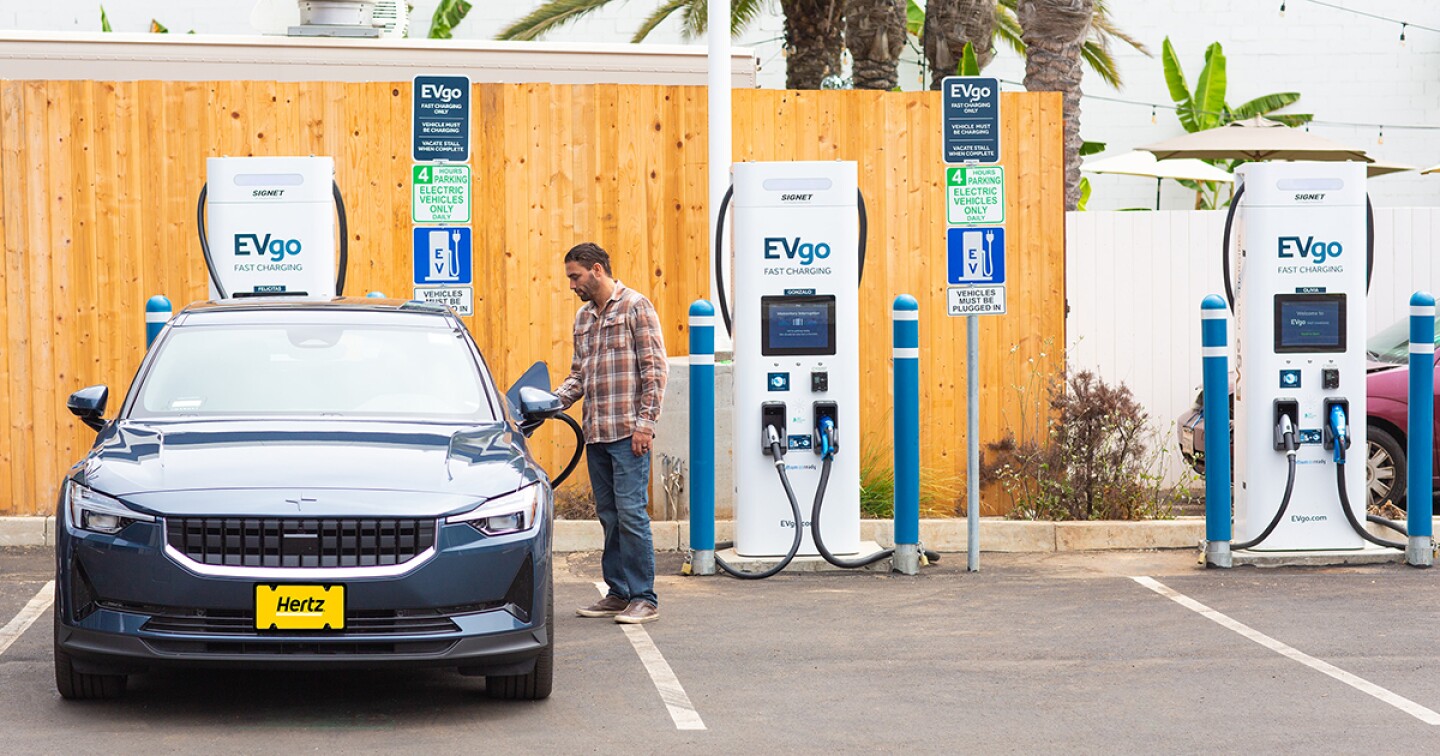EV road-tripping probably conjures one of two images for you: an eco-friendly, quiet, emissions-free ride from the future—or a fraught nightmare of battery-range anxiety and roadside assistance. The truth is, it can be fully the former if you keep a few things in mind. I’ve driven a Polestar 2 some 300 miles from L.A. to Las Vegas and taken a multigenerational road trip to San Diego in a Rivian R1S. Both journeys were smooth, much cheaper by the mile, and kinder to the environment. Here’s a primer on taking an EV road trip of your own.
How range and recharging work
There are three main things to know when driving an EV on a road trip: how far the car can go on a full charge (known as its range), how long it takes to recharge the battery, and where to find charging stations (and what kind).
Ranges differ. Most modern EVs offer between 200 and 400 miles. Charging infrastructure likewise is not created equal. California leads the way, with New York, Florida, and Texas on its heels. Other states have made great progress; Colorado has been working on adding charging capabilities to its scenic byways for several years. The recent federal infrastructure bill is channeling $7.5 billion toward half a million more chargers by 2030. Finally, charging time also varies. A fast charger will get you back on the road within 30 minutes. Slower plugs can take as long as humans to recharge overnight. (The type of car you have and the size of its battery are also factors.)

Hertz and EVgo have teamed up to make borrowing an electric vehicle easier.
Courtesy of EVgo
Renting an EV
Car rental companies are a great place to take a test drive into the inevitable EV world. Hertz, for example, says it has tens of thousands of EVs at more than 2,000 sites in 44 states, and it’s building a fleet at a range of price points (although it has been in the news lately for selling off some of its fleet). The company has a quick guide to renting an EV on Hertz.com, with notes on charging and braking, and primers on different car models, as well as a partnership offering discounts with charging network EVgo.
The peer-to-peer car-sharing platform Turo, meanwhile, launched an EV hub in April. It showcases three curated EV collections (budget, SUV, and luxury) and has tips on driving electric vehicles. The app offers 1,500 makes and models; EVs made up 9 percent of its listings at the end of 2023.
How to find an EV charger
ChargePoint offers the most locations in the United States, with more than 31,000 locations. Electrify America and EVgo are two other popular networks, with more than 900 and 950 charging stations, respectively. Electrify America has an explainer on topping up, including a note on the “charging curve” (charging accelerates in the middle of the session) and other considerations like compatibility. (There are a couple of different plugs, but most modern cars can connect with any of them). Added bonus? The network’s energy is 100 percent renewable via solar farms and renewable energy certificates.
When you plan your route, look for pit stops with at least four outlets, says Joel Levin, executive director of EV advocacy nonprofit Plug In America. That way you’re less likely to find them all in use or have issues if a charger is out of service. “Road-tripping in an EV can be a lot of fun, but it takes a little planning and a different way of thinking about your trip,” he adds.
Use maps and apps
There are two keys to a stress-free trip: maps and apps. Waze added EV charging stations in 2023. Google Maps updated its offering for Earth Day 2024, with more specific location information, forecasted energy consumption for trips, and more. And for EVs with Google Maps built in, including Polestar, Volvo, and Renault vehicles, the software will automatically suggest charging stops when you plan a trip. It also shows charging options at other businesses such as grocery stores.
The charging networks have their own apps, too, allowing you to add payment methods, find available stations, and monitor progress if you leave your vehicle for a while. PlugShare, meanwhile, is a free community-based app that shows nearby chargers and reviews from users.
Book a hotel with an EV charger
Another pro tip: Find hotels with plentiful plugs. With the right combination of high range, shorter distances, and overnight charging, you may not need to stop during your daily drives. The Hilton chain lets you filter your search by hotels with charging facilities (and displays more than 1,200 results in the United States alone). Marriott offers a similar filter; I found 1,172 hotels on a recent search. IHG Hotels & Resorts, meanwhile, has facilities at almost 1,200 hotels in the United States. Some 30 percent of Relais & Châteaux’s North American hotels have chargers.
“Booking a hotel with an EV charger reduces stress and uncertainty,” says Bruce Becker, owner of the zero-emissions Hotel Marcel in Connecticut and an EV owner since 2011. “EV drivers actually have an advantage over drivers with gas cars because you’ll wake up in the morning with a full charge, ready to hit the road.”
Becker, who is chairman of the state’s Electric Vehicle Owners Club, has plenty of recommendations for your first EV road trip. In the summer, he vouches for Cape Cod (“there are plenty of fast chargers along [Interstates] 95 and 91”); in the fall, he suggests a foliage trip from Hotel Marcel to Woodstock, Vermont, or to Maine. In fact, most of the country can be road-tripped in an EV with a little preparation, making it fairly easy to take your foot off the gas.








